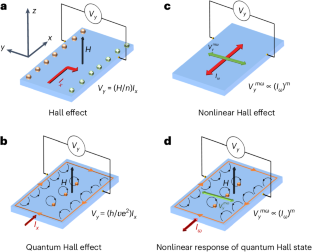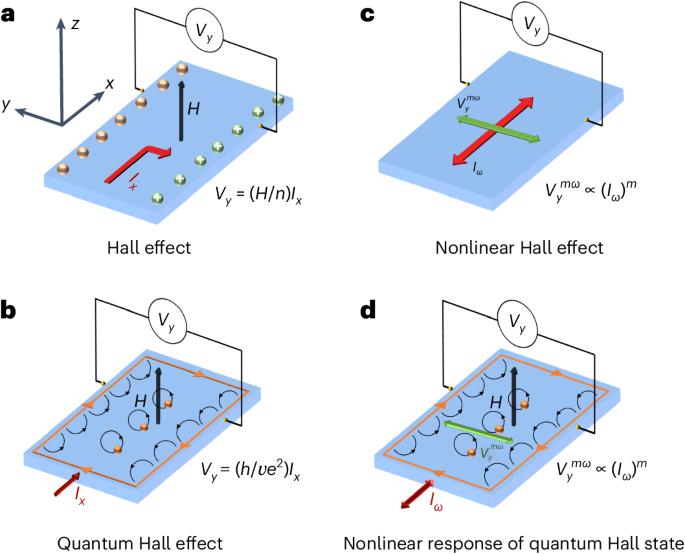Third-order nonlinear Hall effect in a quantum Hall system
IF 38.1
1区 材料科学
Q1 MATERIALS SCIENCE, MULTIDISCIPLINARY
引用次数: 0
Abstract
In two-dimensional systems, perpendicular magnetic fields can induce a bulk band gap and chiral edge states, which gives rise to the quantum Hall effect. The quantum Hall effect is characterized by zero longitudinal resistance (Rxx) and Hall resistance (Rxy) plateaus quantized to h/(υe2) in the linear response regime, where υ is the Landau level filling factor, e is the elementary charge and h is Planck’s constant. Here we explore the nonlinear response of monolayer graphene when tuned to a quantum Hall state. We observe a third-order Hall effect that exhibits a nonzero voltage plateau scaling cubically with the probe current. By contrast, the third-order longitudinal voltage remains zero. The magnitude of the third-order response is insensitive to variations in magnetic field (down to ~5 T) and in temperature (up to ~60 K). Moreover, the third-order response emerges in graphene devices with a variety of geometries, different substrates and stacking configurations. We term the effect third-order nonlinear response of the quantum Hall state and propose that electron–electron interaction between the quantum Hall edge states is the origin of the nonlinear response of the quantum Hall state. Monolayer graphene in the quantum Hall regime exhibits a third-order nonlinear Hall response, which is robust against variations in magnetic field and temperature and provides insights into the interaction of chiral edge states.


量子霍尔系统中的三阶非线性霍尔效应。
在二维系统中,垂直磁场可以诱发体带隙和手性边缘态,从而产生量子霍尔效应。量子霍尔效应的特征是零纵向电阻(Rxx)和霍尔电阻(Rxy)高原,在线性响应机制中量化为 h/(υe2),其中 υ 是朗道水平填充因子,e 是基本电荷,h 是普朗克常数。在这里,我们探讨了单层石墨烯在调谐到量子霍尔态时的非线性响应。我们观察到一种三阶霍尔效应,它表现出一个非零电压高原,与探针电流成立方缩放。相比之下,三阶纵向电压仍然为零。三阶响应的大小对磁场变化(低至 ~5 T)和温度变化(高至 ~60 K)不敏感。此外,三阶响应出现在具有各种几何形状、不同基底和堆叠配置的石墨烯器件中。我们将这种效应称为量子霍尔态的三阶非线性响应,并提出量子霍尔边缘态之间的电子-电子相互作用是量子霍尔态非线性响应的起源。
本文章由计算机程序翻译,如有差异,请以英文原文为准。
求助全文
约1分钟内获得全文
求助全文
来源期刊

Nature nanotechnology
工程技术-材料科学:综合
CiteScore
59.70
自引率
0.80%
发文量
196
审稿时长
4-8 weeks
期刊介绍:
Nature Nanotechnology is a prestigious journal that publishes high-quality papers in various areas of nanoscience and nanotechnology. The journal focuses on the design, characterization, and production of structures, devices, and systems that manipulate and control materials at atomic, molecular, and macromolecular scales. It encompasses both bottom-up and top-down approaches, as well as their combinations.
Furthermore, Nature Nanotechnology fosters the exchange of ideas among researchers from diverse disciplines such as chemistry, physics, material science, biomedical research, engineering, and more. It promotes collaboration at the forefront of this multidisciplinary field. The journal covers a wide range of topics, from fundamental research in physics, chemistry, and biology, including computational work and simulations, to the development of innovative devices and technologies for various industrial sectors such as information technology, medicine, manufacturing, high-performance materials, energy, and environmental technologies. It includes coverage of organic, inorganic, and hybrid materials.
 求助内容:
求助内容: 应助结果提醒方式:
应助结果提醒方式:


